Belkin AC1900 DB Wireless AC Router F9K1124 User Manual
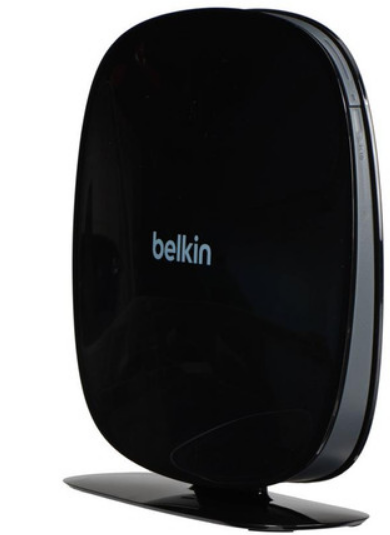
Content
Introduction
The Belkin AC1900 DB Wireless AC Router F9K1124 is designed to deliver high-speed internet connectivity and robust performance for modern households. With dual-band technology, it offers speeds of up to 600 Mbps on the 2.4 GHz band and 1.3 Gbps on the 5 GHz band, ensuring smooth streaming and gaming experiences. The router features easy setup via smartphone and includes four Gigabit Ethernet ports for wired connections. Priced at approximately $109, it provides excellent value for reliable home networking.
Getting Started
What’s in the Box
- AC1900 DB Wireless AC+ Gigabit Router
- Ethernet cable (attached to router)
- Power supply (attached to router)
- Network information card (attached to router)
Quick Setup Guide
Initial Setup
Where to Place Your Router
For the best results, place the router next to your modem in an open location, away from large metal objects and magnets such as those found in speakers. Raising the router above floor level can improve the strength of your wireless signal.
How to Set It Up
Connect Your AC1900 DB Router
Turn off your modem by disconnecting its power supply. Some modems have a battery backup; this will need to be disconnected at this time as well.
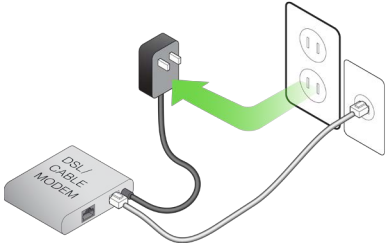
Connect your router to your modem using the cable (already attached).

Power up your modem by plugging in its power supply. If your modem has a battery backup, it can be reconnected at this time; you may need to hold the reset button for 10 seconds. Power up your router by plugging in its power supply.
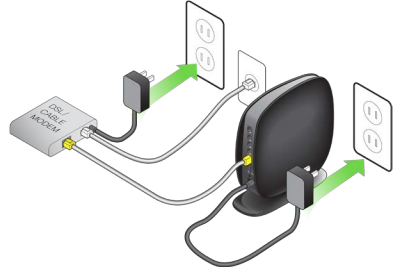
Specifications
- Dual-band technology: 2.4GHz and 5GHz bands for optimal performance
- Speed: Up to 1900 Mbps (600 Mbps on 2.4GHz, 1300 Mbps on 5GHz)
- Processor: 1 GHz dual-core processor
- Memory: 256 MB RAM and 128 MB flash memory
- Antennas: 3 external adjustable antennas for enhanced coverage
- USB Ports: 1 USB 3.0 and 1 USB 2.0 for file sharing and printer sharing
- Security: WPA2 encryption, guest network access, and firewall protection
- Other Features: RangeBoost technology, QoS for prioritizing traffic, and Intellistream QoS
Getting to Know Your Router
Front Panel
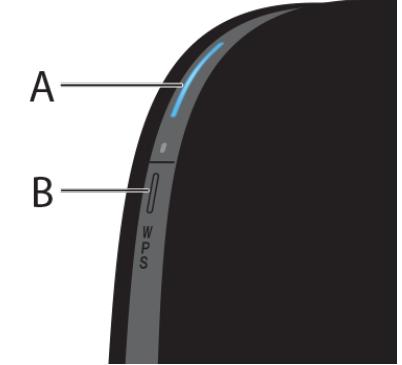
Router Status Light (A)
- Off: The router is not plugged into a power source.
- Blinking Blue: The router is starting up.
- Solid Blue: The router is connected to the Internet.
- Blinking Amber: The router can’t detect the modem. Either the modem is off, is not plugged into the router, or is unresponsive.
Wi-Fi Protected Setup (WPS) Light and Button (B)
The WPS button on the front of your router can be used to help establish a secure connection between your router and other WPS-enabled Wi-Fi devices such as computers. To use WPS, refer to page 10.
The small light near the WPS button shows what is happening while you are using WPS to establish a connection.
- Off: Idle
- Blinking Blue: The Router is listening for a WPS-enabled computer or other device.
- Solid Blue: The Router has made a secure connection with the computer or other device.
- Amber: A connection was not created.
Back Panel
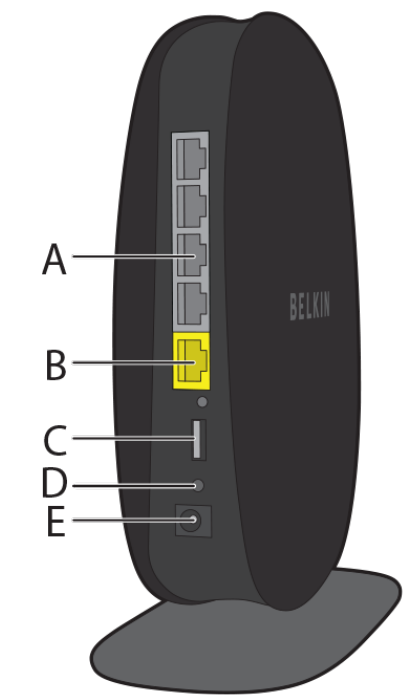
- Modem (WAN) Connector (A)
Connect your modem to this port using an Ethernet cable.
Wired (LAN) Connectors (B)
Connect computers and other wired network devices to these ports using Ethernet cables. - USB Port (C)
USB printers, drives, and other USB devices plugged into this port will be shared on your network. Each USB port has a light that indicates its status.- Off: No USB device is connected or the attached USB device is not in use.
- Blinking: Please wait to unplug the device until the light turns off.
- Solid: The USB device is connected and being shared on your network.
- Reset Button (D)
This button is used to restart your router in rare cases when it functions incorrectly. Resetting the router will preserve your settings. This button may also be used to restore the factory default settings. - Power Connector (E)
Connect the included power supply to this jack.
Belkin AC1900 DB Wireless AC Router F9K1124 Technical Features
- Integrated 802.11n Wireless Access Point
Utilizing Dual-Band Network technology, your router creates two separate networks (one at 2.4GHz band and the other at 5GHz band), allowing increased bandwidth to all your connected wireless devices and computers. - NAT IP Address Sharing
To save you the cost of adding IP addresses per computer in your house, your Belkin router uses Network Address Translation (NAT) technology, allowing you to share a single IP address across your network. - SPI Firewall
Your router is equipped with a firewall that will protect your network from a wide array of common attacks and viruses. - Universal Plug-and-Play (UPnP) Compatibility
UPnP offers seamless operation of voice and video messaging, games, and other applications that are UPnP-compliant. - Web-Based Advanced User Interface
You can easily make changes to your router’s advanced settings through your web browser. These changes can be made from any computer on your network. - Integrated 4-Port Gigabit Switch
Your router has a built-in, 4-port network switch to allow your wired computers to share: printers, data, MP3 files, digital photos, and much more. - USB Port
The USB port lets you plug in printers, hard drives, and other USB devices to share across your network. - System Requirements
- Router
- Broadband Internet connection such as a cable or DSL modem with RJ45 (Ethernet) connection
- At least one computer with an installed network interface adapter
- TCP/IP networking protocol installed on each computer
- RJ45 Ethernet networking cable
- Internet browser
- Setup
- A computer running Internet Explorer 8 or higher, Firefox, Google Chrome, or Safari
- Minimum 1GHz processor and 512MB RAM
- Or a smart device running iOS or Android operating systems
- USB Print and Storage Manager
- Windows XP SP3 or higher, Windows Vista, or Windows 7; or Mac OS X v10.5 or above
- Minimum 1GHz processor and 512MB RAM
- 50MB of free hard-drive space for installation
Description
The Belkin AC1900 DB Wireless AC Router F9K1124boasts a robust design with three adjustable antennas that help in maximizing the coverage area. The router features a sleek and compact body that fits well in any home or office setup. It supports the latest 802.11ac Wi-Fi standard, ensuring compatibility with a wide range of devices. The intuitive web-based interface makes it easy to set up and manage the router, even for those who are not tech-savvy.
The router also includes advanced features such as RangeBoost technology, which helps in extending the Wi-Fi range and reducing dead spots. Additionally, Intellistream QoS allows you to prioritize traffic for critical applications like video streaming and online gaming.
Using Your Router
Auto Update on Your Belkin Router
The router will automatically check for a newer version of firmware every time you log into the dashboard and alert you with a message at the top of the screen if there is an update available. You can choose to download the new version or ignore it.
You will see a series of prompts warning you that the firmware is about to be updated. Please do not disconnect the power from the router at this time as it could cause the system to fail.
Updating the Router’s Firmware via the Web Interface
The following steps show you how to update your router’s firmware using its web interface. You do not need to be connected to the Internet as this interface is built into the router itself.
Setup steps:
- Locate and download the firmware file from the Belkin support site. (Type your part number into the search box in the top right corner and look for “Firmware” in the title.)
- Save the file to a location on your computer where you can get to it easily, such as your desktop.
Connect the computer to one of the four LAN ports on the router (refer to image).

- Open a web browser on the computer.
- In the address bar of the web browser, type “http://router” or “http://192.168.2.1” and press Enter on your keyboard.
Click on Firmware Update toward the bottom right corner.

Click Choose File toward the middle of the screen to search for the file you saved previously.

Select the firmware file by left-clicking on it and then click Open in the lower-right corner of the window. This will take you back into the router’s interface.

Note—The firmware version in the image above is depicted as an example. Your file name will vary depending on your model and version.
- Click Update.
- Click OK when you see a prompt asking, “Are you sure you want to continue with upgrading?”
- Click OK at the second prompt telling you the router will not respond during the upgrade and warning you not to remove the power supply from the router.
Setup Guide
To set up the Belkin AC1900 DB Wireless AC Router F9K1124,
- Start by unboxing the router and connecting it to your modem using an Ethernet cable.
- Next, plug in the power cord and turn on the router. Open a web browser on your computer or mobile device and type in the default IP address (usually 192.168.2.1) to access the setup interface.
- Follow the on-screen instructions to configure your Wi-Fi network settings, including setting up your SSID and password.
- You can also set up guest networks and configure other advanced settings through this interface.
- For pairing devices, simply connect them to your new network using the SSID and password you created during setup.
Resetting the Router
Reset Button – Red
The Reset button is for rare cases when the router functions improperly. A simple reset will restore normal operation while maintaining programmed settings. You can also restore to factory default settings by using the Reset button. Use the restore option in instances where you may have forgotten your custom password.
Simple Reset
Push and release the Reset button. The lights on the router will momentarily flash. The router status light will begin to blink. When the router status light is solid again, the reset is complete.
Restore to Factory Defaults
Press and hold the Reset button for at least 5 seconds. The lights on the router will momentarily flash. The router status light will begin to blink. When the router status light is solid again, the restore is complete.
Restoring the Router to Default Settings Using the Web Interface
- Open a web browser on the computer.
- In the address bar of the web browser, type “http://router” or “http://192.168.2.1”.
Click on Restore Factory Defaults in the far-right column under Utilities.
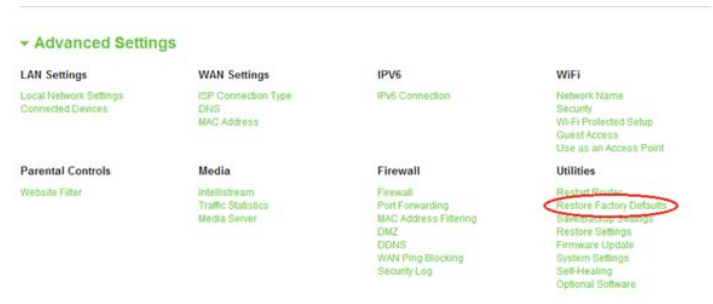
Click Restore Defaults.

Click OK in the warning box that says, “Warning: All Your Settings Will Be Lost! Are You Sure You want to do this?”
Once the restore is complete, the router will reboot. The process might take several minutes.
Troubleshooting Guide
My device can’t connect to the Internet wirelessly.
- If the router status light is solid blue, your router is connected to the Internet. Your device might not be connected to the router’s wireless network. Please refer to "Connect Your Wireless Devices" on page 18 for instructions.
- If your Windows XP computer is running SP2, you will not be able to set up the router via the wireless setup process. You will need to update to Windows XP SP3 or complete the setup via a wired connection.
I can’t connect to the Internet wirelessly and my network name is not listed in Available Networks.
- Verify that your router is on and the router status light is solid blue.
- If you are far from the router, try moving closer to see if you are out of range.
- Using a computer attached to the router via a network cable, visit http://router/ and ensure that Broadcast SSID is ON. This setting is found on the Channel and SSID page.
My wireless network performance is slow, inconsistent, suffers from weak signal, or I’m having difficulty maintaining a VPN connection.
Wireless technology is radio-based. Connectivity, speed, and throughput between devices decrease as distance between devices increases. Other factors that will cause signal degradation are obstructions such as walls and metal appliances. To determine if wireless issues are related to range, we suggest temporarily moving a connected device to within 10 feet from the router, if possible.Some things you can do to improve your router’s performance:
- Changing the wireless channel: Depending on local wireless traffic and interference, switching the wireless channel of your network can improve performance and reliability.
- Limiting the wireless transmit rate: Limiting the wireless transmit rate can help improve range and connection stability. Most wireless cards have the ability to limit the transmission rate. To change this property in Windows, go to the Windows Control Panel, open Network Connections, and double-click on your wireless card’s connection. In the properties dialog, select Configure on the General tab, then choose the Advanced tab and select the rate property.
Wireless client cards are usually set to automatically adjust the wireless transmit rate for you, but doing so can cause periodic disconnects when the wireless signal is too weak; as a rule, slower transmission rates are more stable. Experiment with different connection rates until you find the best one for your environment. Note that all available transmission rates should be acceptable for browsing the Internet.
I’ve installed this new router and some of my network clients (computers, game consoles, etc.) are now unable to connect.
Your new router came preconfigured with a network name and password. That information is printed on a card attached under the foot of the router. All clients must use this network name and password to connect wirelessly to your router. Find the network settings on your client, select the network name printed on the card from the list of available networks, and enter the password when prompted to join the wireless network.
Does the router support Wireless Protected Access (WPA) security?
The router ships with WPA/WPA2 security turned on. Windows XP and some older network hardware may require a software update to support WPA/WPA2.
I am having difficulty setting up WPA security on my router.
- Log in to your router by visiting “http://router/” or “http://192.168.2.1” with your web browser. Click Security under the WiFi heading; you should now be on the Security page.
- Under Security Mode, select WPA/WPA2-Personal (PSK).
- Select WPA/WPA2 from the drop-down menu under Authentication.
- Enter a password (8–63 characters) or a 64-digit hexadecimal number (using only numbers 0–9 and letters A–F).
- Click Save to finish; your wireless connection is now encrypted.
Notes: If you are configuring the router over a wireless connection, you will have to reconnect after changing any security settings.Some older networking hardware supports only WEP encryption; if older computers cannot connect, try 128-bit or 64-bit WEP or seek software updates from their manufacturers.
I am having difficulty setting up Wired Equivalent Privacy (WEP) security on my router.
- Log in to your router by entering http://router/ or “http://192.168.2.1” in a web browser; click Security under Wi-Fi heading.
- Under Security Mode, select 128-bit WEP option.
- You may type in a WEP key manually or generate one from a passphrase.
- Click Save to finish; your wireless activity is now encrypted.
Notes: If configuring over a wireless connection, reconnect after changing any security settings.Some older networking hardware supports only 64-bit WEP encryption; if older computers cannot connect, try 64-bit WEP.A drive I plugged into the USB port is not showing up on my computer.
- Try unplugging and plugging it back in; check that it’s firmly connected.
- If your drive has an optional power supply, use it while attached.
- The router supports FAT16, FAT32, or NTFS formats; drives in other formats will not appear.
A drive plugged into the USB port is not coming on or remains on only for a short time.
Some drives require more power than provided by the router’s USB port; use an optional power supply if available.
A printer I plugged into the USB port is not showing up on my computer.
- Try unplugging and plugging it back in; ensure it’s firmly connected.
- Install that printer’s driver on your computer.
- Check that auto-connect is selected in USB Print and Storage Center.
A different sort of USB device that I plugged into the USB port is not showing up on my computer.
Most USB devices other than storage drives and printers must be accessed via USB Print and Storage Center.
- Try unplugging and plugging it back in; check that it’s firmly connected.
- Open USB Print and Storage Center; check if it appears in available devices.
- Select it and click Use; it will be virtually connected until you choose to stop using it or another person requests use of it.
Pros & Cons
Pros:
- High Performance: Delivers fast speeds suitable for heavy internet usage.
- Dual-Band Technology: Optimizes performance by separating traffic between 2.4GHz and 5GHz bands.
- Advanced Features: Includes RangeBoost and Intellistream QoS for enhanced coverage and traffic prioritization.
- User-Friendly Interface: Easy setup and management through a web-based interface.
Cons:
- Cost: Pricier compared to some other routers in its class.
- Heat Issues: Some users have reported overheating issues during prolonged use.
- Firmware Updates: Requires occasional firmware updates which can sometimes cause connectivity issues.
Customer Reviews
Customers have generally praised the Belkin Wireless AC Router AC1900 DB for its reliable performance and strong signal strength. Many users appreciate its easy setup process and the ability to customize settings through the web interface. However, some have noted that it can be bulky and may experience overheating issues over time.
Common complaints include occasional drops in connectivity and the need for frequent firmware updates. Despite these minor issues, most users find it to be a solid choice for their home networking needs.
Warranty
What this warranty covers
Belkin International, Inc. (“Belkin”) warrants to the original purchaser of this Belkin product that the product shall be free of defects in design, assembly, material, or workmanship.
What the period of coverage is
Belkin warrants the Belkin product for two years.
Faqs
What is the maximum speed of the Belkin Wireless AC Router AC1900 DB?
How many USB ports does this router have?
What security features does this router offer?
Can I prioritize traffic on this router?
How do I update the firmware of my Belkin Wireless AC Router AC1900 DB?
Is this router compatible with older devices that use 802.11n?
How many external antennas does this router have?
Can I reset my Belkin Wireless AC Router AC1900 DB to its factory settings?
Does this router support guest networks?
What is RangeBoost technology in this router?
Leave a Comment
